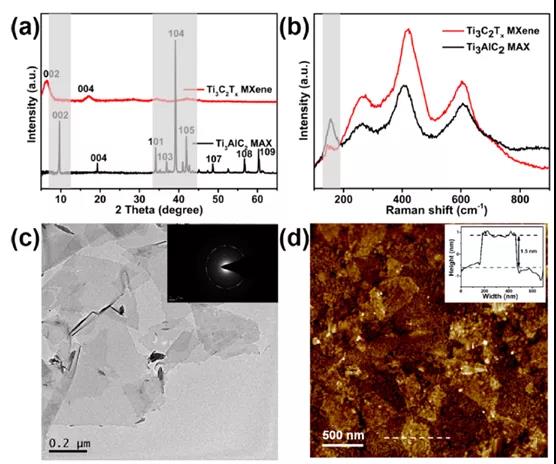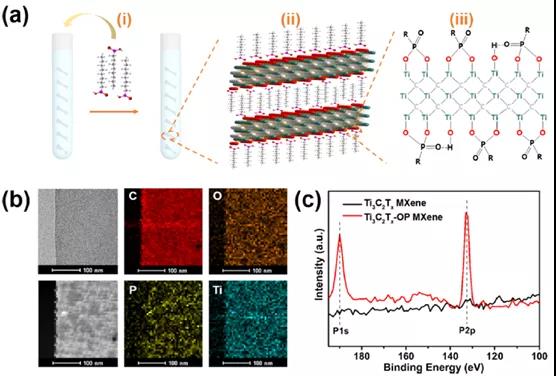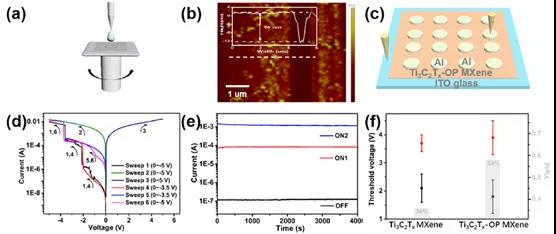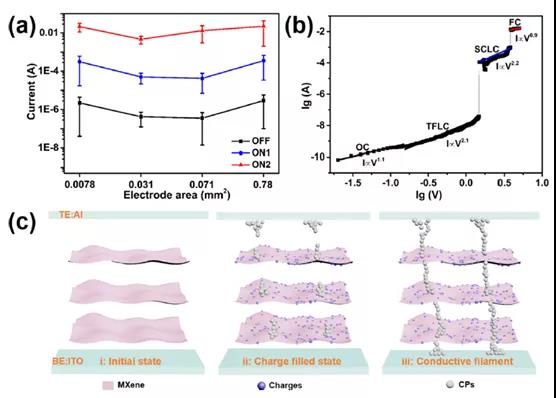Surface-functionalized single-layer MXene in multi-level memristor
QQ Academic Group: 1092348845
Detailed
[Research background]
With the exponential growth of digital information, traditional flash memory devices are difficult to meet the requirements of information density due to the limitation of Moore‘s Law. In order to increase the density of information, there is an urgent need to innovate in new materials and device structures. Resistive random access memories (RRAMs) have been widely studied because of their advantages of simple structure (metal-insulator-metal), high scalability, fast read and write speed, and low power consumption. This technology has proven to be compatible with conventional complementary metal oxide semiconductors. In addition, RRAMs can obtain multiple discrete resistance values, which correspond to "0" "1" "2" ... In addition, low power consumption is particularly important for equipment, and low operating voltage has better energy saving effects on electronic products . At present, most RRAMs based on transition metal oxides require higher operating voltage and larger leakage current. However, in research and industry, there is growing interest and demand for flexible displays and easily foldable electronic devices. Therefore, in order to solve these problems, there is an urgent need to develop new memory device functional materials with low energy, multi-resistance, and high flexibility. MXene has been extensively studied in fields such as supercapacitors and sensors. However, there is little research on MXene in Non-Volatile Information Memory (NVIM). It is necessary to expand its application field through surface modification engineering.
【Achievement Introduction】
Recently, Professor He Jinghui and Professor Lu Jianmei of Suzhou University published a research paper titled: Surface Functionalization of Single-Layered Ti3C2Tx MXene and Its Application in Multilevel Resistive Memory in the internationally renowned academic journal ACS Applied Materials & Interfaces. Ti3C2Tx MXene (Ti3C2Tx-op) modified with octylphosphonic acid was used as the active layer, and a simple Al / Ti3C2Tx-opMXene layer / ITO glass memory device was fabricated. Ti3C2Tx-OPMXene memory has the characteristics of low threshold voltage, stable holding time, clearly distinguishable resistance status, high on / off rate, OFF / ON1 / ON2 = 1:10:10, and three-component yield (58%). In addition, the flexible Ti3C2Tx-OPMXene storage device based on polyethylene terephthalate (PET) can maintain its stable ternary storage performance even after a curvature radius of ρ = 2.1 cm for 5000 cycles. This work provides a convenient method for surface modification of MXene and broadens the field of MXene.
[Graphic introduction]

Figure 1. Performance characterization of Ti3AlC2MAX and Ti3C2Tx MXene.

Figure 2. Physical characterization of monolayer Ti3C2Tx MXene before and after modification with octylphosphonic acid.

Figure 3. Ti3C2Tx-OPMXene memory device diagram and related electrical properties.

Figure 4. Ti3C2Tx-OPMXene memory mechanism research.

Figure 5. Ti3C2Tx-OP MXene flexible memory device diagram and related electrical properties.
【Summary of this article】
The research in this paper proves that Ti3C2Tx-OP MXene is a candidate for nonvolatile ternary memory devices and has excellent flexibility. It shows easy-to-operate surface modification engineering, simple equipment structure, long retention time (4000 s), high on / off rate, OFF / ON1 / ON2 = 1:10:10 and good ternary yield (58%), and excellent flexibility. Therefore, this research broadens the field of Ti3C2Tx-OPMXene and shows a new direction for the storage of massive information. In addition, the research on flexible Ti3C2Tx-OPMXene memory devices is of great significance for the development and application of flexible electronic devices.
Literature link:
With the exponential growth of digital information, traditional flash memory devices are difficult to meet the requirements of information density due to the limitation of Moore‘s Law. In order to increase the density of information, there is an urgent need to innovate in new materials and device structures. Resistive random access memories (RRAMs) have been widely studied because of their advantages of simple structure (metal-insulator-metal), high scalability, fast read and write speed, and low power consumption. This technology has proven to be compatible with conventional complementary metal oxide semiconductors. In addition, RRAMs can obtain multiple discrete resistance values, which correspond to "0" "1" "2" ... In addition, low power consumption is particularly important for equipment, and low operating voltage has better energy saving effects on electronic products . At present, most RRAMs based on transition metal oxides require higher operating voltage and larger leakage current. However, in research and industry, there is growing interest and demand for flexible displays and easily foldable electronic devices. Therefore, in order to solve these problems, there is an urgent need to develop new memory device functional materials with low energy, multi-resistance, and high flexibility. MXene has been extensively studied in fields such as supercapacitors and sensors. However, there is little research on MXene in Non-Volatile Information Memory (NVIM). It is necessary to expand its application field through surface modification engineering.
【Achievement Introduction】
Recently, Professor He Jinghui and Professor Lu Jianmei of Suzhou University published a research paper titled: Surface Functionalization of Single-Layered Ti3C2Tx MXene and Its Application in Multilevel Resistive Memory in the internationally renowned academic journal ACS Applied Materials & Interfaces. Ti3C2Tx MXene (Ti3C2Tx-op) modified with octylphosphonic acid was used as the active layer, and a simple Al / Ti3C2Tx-opMXene layer / ITO glass memory device was fabricated. Ti3C2Tx-OPMXene memory has the characteristics of low threshold voltage, stable holding time, clearly distinguishable resistance status, high on / off rate, OFF / ON1 / ON2 = 1:10:10, and three-component yield (58%). In addition, the flexible Ti3C2Tx-OPMXene storage device based on polyethylene terephthalate (PET) can maintain its stable ternary storage performance even after a curvature radius of ρ = 2.1 cm for 5000 cycles. This work provides a convenient method for surface modification of MXene and broadens the field of MXene.
[Graphic introduction]

Figure 1. Performance characterization of Ti3AlC2MAX and Ti3C2Tx MXene.

Figure 2. Physical characterization of monolayer Ti3C2Tx MXene before and after modification with octylphosphonic acid.

Figure 3. Ti3C2Tx-OPMXene memory device diagram and related electrical properties.

Figure 4. Ti3C2Tx-OPMXene memory mechanism research.

Figure 5. Ti3C2Tx-OP MXene flexible memory device diagram and related electrical properties.
【Summary of this article】
The research in this paper proves that Ti3C2Tx-OP MXene is a candidate for nonvolatile ternary memory devices and has excellent flexibility. It shows easy-to-operate surface modification engineering, simple equipment structure, long retention time (4000 s), high on / off rate, OFF / ON1 / ON2 = 1:10:10 and good ternary yield (58%), and excellent flexibility. Therefore, this research broadens the field of Ti3C2Tx-OPMXene and shows a new direction for the storage of massive information. In addition, the research on flexible Ti3C2Tx-OPMXene memory devices is of great significance for the development and application of flexible electronic devices.
Literature link:
https://dx.doi.org/10.1021/acsami.9b16979.
Source: MXene Frontier
- Previous: Professor Xu Bin of Be
- Next: MXene breakthrough: Na


 mxene academic
mxene academic
